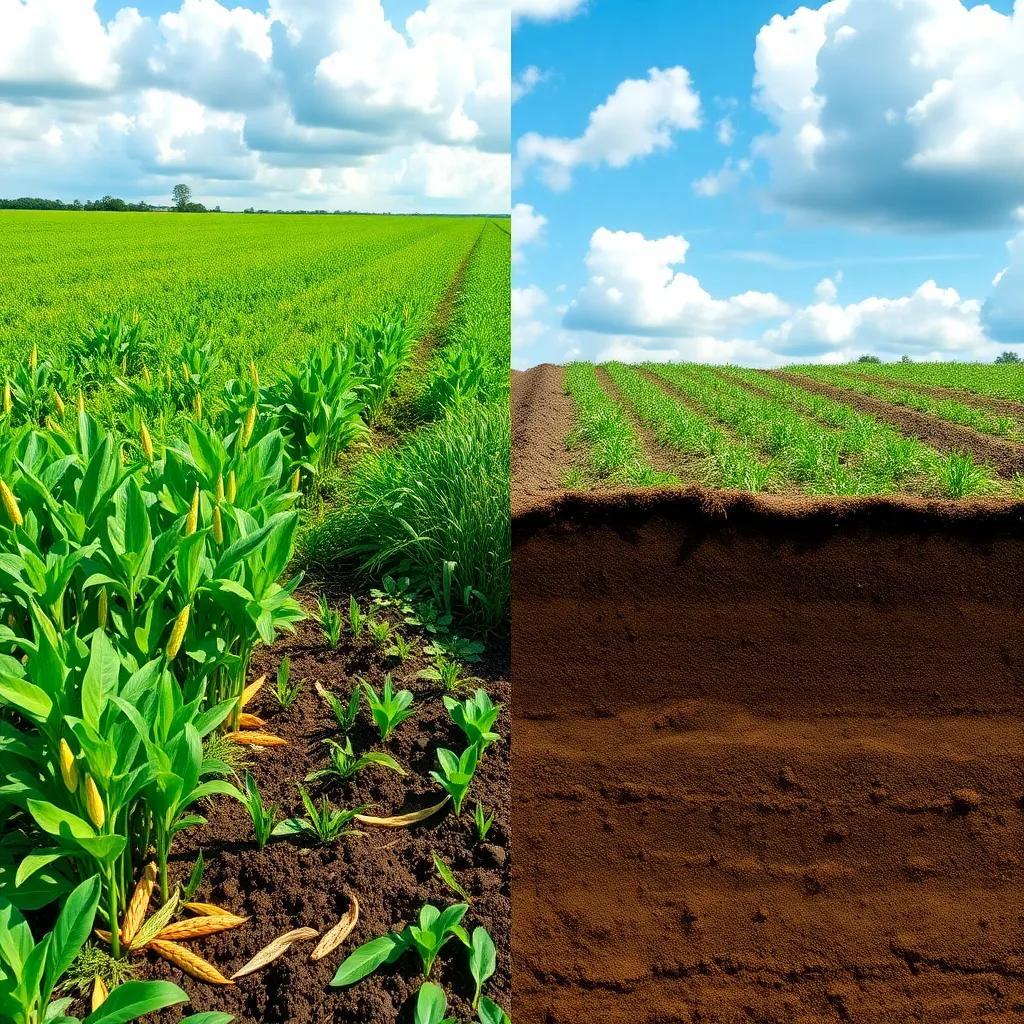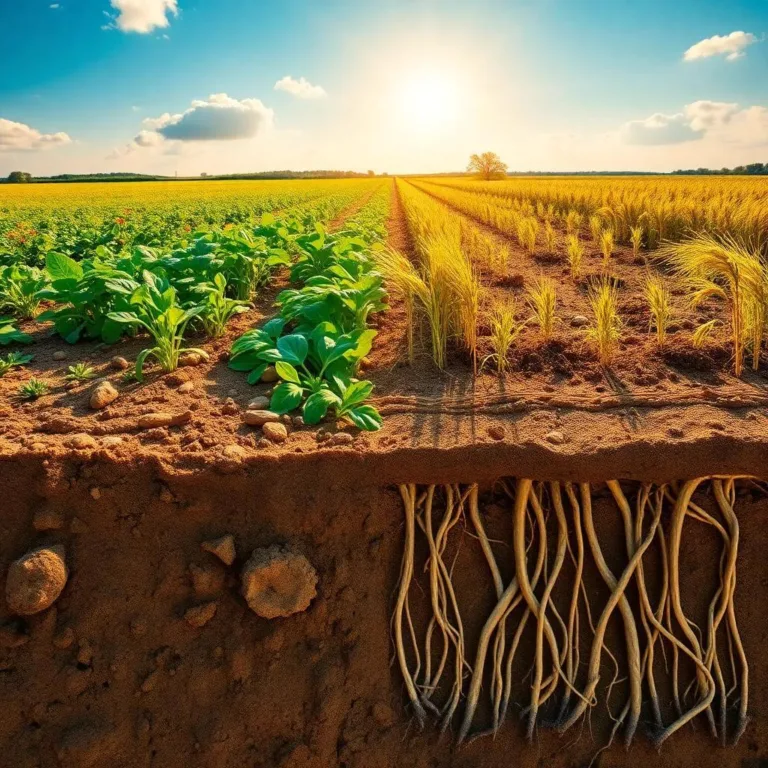Have you ever wondered how farmers keep their soil healthy and full of life? It’s all about crop rotation and conservation plowing! In this article, I’ll share how these amazing practices work together to support strong crops, manage pests, and create a thriving ecosystem in our fields. Let’s dig in and explore the secrets of sustainable farming! 🌱
Benefits of Crop Rotation for Soil Conservation
Crop rotation is like giving your soil a good workout! By alternating the types of crops planted in a field, farmers help keep the soil healthy, happy, and productive. So, why is this practice so beneficial? Let me share some of the great perks with you!
- Improved Soil Fertility: Different crops have different nutrient needs. For instance, legumes, such as beans and peas, are like nature’s little helpers. They can fix nitrogen from the air and add it to the soil, making it richer for the next batch of plants. This way, the soil doesn’t get depleted, and your future crops thrive!
- Reduced Pest and Disease Pressure: Have you ever noticed how pests seem to love certain plants? When you grow the same crop year after year, those pesky pests and diseases can build up. But with crop rotation, you’re throwing a wrench in their plans! Changing crops means that pests and diseases have a harder time getting cozy, which means less need for chemical pesticides. That sounds great, right?
- Enhanced Soil Structure: Different crops have unique root systems. Some plants dig deep, while others spread wide. By mixing it up, the soil gets a full-body workout! This helps improve soil structure, drain water better, and keep it from getting compacted. Healthy soil means healthier plants!
- Optimized Nutrient Cycling: Every crop has its own way of taking and giving back nutrients. By rotating, farmers can make sure nutrients are used wisely and not wasted. This reduces the use of synthetic fertilizers, which benefits both your wallet and the environment!
So, crop rotation is not just good for the soil; it’s a fantastic strategy for sustainability and productivity in farming! Who knew a little change could make such a big difference?
How Conservation Plowing Minimizes Soil Disturbance
Now, let’s chat about conservation plowing. This practice is all about keeping the soil intact and minimizing disturbance. Imagine you’re hosting a party, and you don’t want to mess up your lovely living room! That’s what conservation plowing does for the soil.
Instead of turning the soil upside down like traditional plowing, conservation plowing keeps the soil structure mostly undisturbed. Here’s why that’s awesome:
- Prevents Soil Erosion: By minimizing disturbance, the soil is less likely to wash away with rain or blow away with the wind. It’s like giving your soil a protective shield! This practice helps keep nutrients locked in the soil where they belong.
- Promotes Organic Matter: Leaving crop residues on the surface is like laying down a cozy blanket for the soil. It helps protect the soil and adds organic matter over time, which enriches it. Who wouldn’t want rich, nutrient-packed soil?
- Encourages Soil Life: Healthy soil is teeming with life—think worms, microbes, and all sorts of critters! Conservation plowing creates a more inviting environment for these beneficial organisms since they thrive in undisturbed soil. These little helpers contribute to nutrient cycling, making your soil even better.
- Increases Water Infiltration: When soil is plowed less intensively, it allows water to seep in more easily. This means plants have access to the moisture they need, especially during dry spells. It’s like pouring a glass of water on a perfectly prepared sponge—no drips wasted!
By adopting conservation plowing, we help keep our soil healthy, vibrant, and ready to support a variety of plants! So let’s give our soil the love it deserves! 🌱

Pest and Disease Management through Crop Rotation
Let’s talk about one of the awesome benefits of crop rotation: pest and disease management! You know how pests seem to love hanging around certain plants, right? Well, crop rotation is like a clever game of hide-and-seek for those pesky critters!
When farmers plant different crops each season, it confuses pests and diseases that target specific plants. Imagine a garden full of tomatoes one year and then suddenly—bam!—it’s all beans the next! Those pests that thrived on tomatoes can’t just jump over to beans; they have to find a new favorite spot!
Here are some key ways crop rotation helps keep pests and diseases at bay:
- Breaking Pest Lifecycles: Many pests have a favorite crop they love to munch on. By rotating crops, farmers disrupt their food sources. This means fewer pests can get settled in and wreak havoc!
- Diversity is Key: When different crops are planted together, the chance of a pest outbreak decreases. A mix of plants creates a buffet of options, which keeps the pests guessing and reduces their populations.
- Natural Disease Resistance: Some crops are naturally resistant to certain diseases. If a resistant crop is planted in rotation, it can help protect the soil and future crops from getting sick!
By using crop rotation, farmers are not just managing pests; they are also maintaining a healthier ecosystem. Who knew rotation could be such a simple yet effective way to keep our gardens blooming beautifully?
Optimizing Nutrient Cycling with Conservation Practices
Now, let’s dive into the exciting world of nutrient cycling and how we can optimize it through conservation practices! Just like how I need a balanced diet to stay healthy, crops require a variety of nutrients to grow strong and productive.
With crop rotation and conservation plowing, farmers can make sure that nutrients circulate effectively in the soil. Here’s how it works:
- Different Nutrient Needs: Each crop has its own nutrient requirements. For example, corn is a heavy feeder of nitrogen, while legumes like peas and beans can fix nitrogen in the soil. By alternating these types, the soil gets what it needs without getting depleted!
- Reducing Fertilizer Dependence: When crops are rotated, it can lessen the need for synthetic fertilizers. This is great for the environment and also cuts costs for farmers! It’s like cooking at home with fresh ingredients rather than relying on takeout every day.
- Adding Organic Matter: Practices like cover cropping or leaving crop residues on the field add valuable organic matter back into the soil. This organic matter breaks down over time and enriches the soil, making it healthier.
By focusing on nutrient cycling, farmers can create a more efficient and sustainable agricultural system. Isn’t it amazing how a thoughtful rotation can lead to happier, healthier crops?
Enhancing Soil Structure through Sustainable Techniques
Let’s wrap things up with a chat about enhancing soil structure! Healthy soil is the foundation of any successful farm, and it’s essential for crop growth. By using sustainable techniques like crop rotation and conservation plowing, we can make the soil structure stronger and more resilient!
Here’s what happens when we focus on soil structure:
- Better Water Infiltration: When crops with different root systems are planted, it creates pathways in the soil. These pathways help water soak in more easily, reducing runoff. It’s like giving water a cozy welcome mat!
- Improved Aeration: Healthy soil is full of tiny spaces that allow air and moisture to circulate. When soil is disturbed less, it retains its structure, letting air in and keeping it fluffy. This is perfect for root growth!
- Supporting Soil Life: A well-structured soil is like a bustling city for microorganisms and earthworms. These tiny critters play a huge role in mixing nutrients and improving soil health. Plus, they help break down organic matter!
- Preventing Compaction: By using conservation plowing, we minimize compaction. Compacted soil can suffocate roots and make it hard for plants to grow. Keeping the soil loose is a farmer’s secret weapon!
When we enhance soil structure with sustainable techniques, we’re not just helping the crops grow; we’re building a thriving ecosystem! It’s a win-win for farmers and our planet! 🌍

